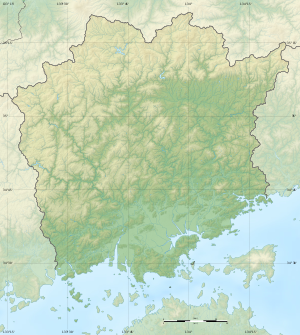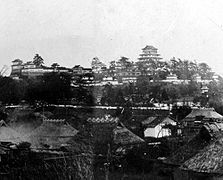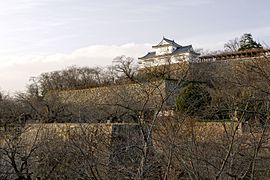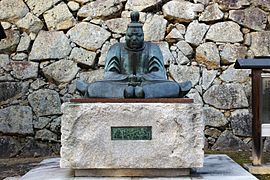Tsuyama Castle
| Tsuyama Castle | ||
|---|---|---|
|
Bitchu watchtower |
||
| Creation time : | 1604-1617 | |
| Castle type : | Hirayamajiro (hill castle) | |
| Conservation status: | Walls preserved | |
| Place: | Tsuyama | |
| Geographical location | 35 ° 3 '46 " N , 134 ° 0' 18" E | |
| Height: | 142 m TP | |
|
|
||
The Tsuyama Castle ( Japanese 津 山城 , Tsuyama-jō ) is located in the city of Tsuyama ( Okayama Prefecture ). Most recently, a branch of the Matsudaira resided there with an income of 100,000 koku .
history
In 1602 the line of the Kobayakawa, lords of the Mimasaka province, died out. In the following year Mori Tadamasa (森 忠 政; 1570-1634) from the Mori clan was entrusted with the fief and the related income of 186,000 Koku. He built Tsuyama Castle from 1604, which was finally completed in 1617. But in the fourth generation, Naganari, whose adoptive son was ill, died out of the line. The fiefdom was transferred in 1698 to the adopted son Nobutomi (宜 富) of Matsudaira Mitsunaga (松 平光 長), a descendant of Tokugawa Ieyasu , with 100,000 koku. The Matsudaira remained lords of the castle until the Meiji Restoration in 1868.
The castle complex
The castle complex encloses the entire mountain Tsuruyama with high stone walls and had a five-story castle tower in the central area, the Hommaru (本 丸). On the east side the mountain drops steeply to the river Miyakawa (宮 川), on the west side Ni-no-maru (二 の 丸) and San-no-maru (三 の 丸) join in an arc. The complex had numerous watchtowers and gates. Moats were dug down on three sides to protect earth walls. The entire complex with the high stone walls, the numerous gates and watchtowers was unique in all of Japan, an almost exaggerated defensive structure. In 1809 the Hommaru was ravaged by a fire, but was then rebuilt.
After the Meiji Restoration , all buildings disappeared, only the walls remained. In 2004 the Bitchū watchtower (備 中 櫓, Bitchū-yagura) in Hommaru was restored on the basis of excavations and with the help of old photos. Part of the trenches are also to be restored.
The entire castle area was transferred to the city in 1900 and today forms Kakuzan Park. This is famous for its cherry blossom.
Remarks
- ↑ Kakuzan is the Sino-Japanese reading of Tsuruyama.
photos
literature
- Kato, Masafumi: Tsuyama-jo in: Miura, Masayuki (Ed.): Shiro to jinya Saiokoku-hen . Gakken, 2006, ISBN 978-4-05-604378-5 , pp. 68-69.
- Nishigaya, Yasuhiro (Ed.): Tsuyama-jo. In: Nihon meijo zukan, Rikogaku-sha, 1993, ISBN 4-8445-3017-8 .
- Okayama-ken no rekishisampo henshukai (Ed.): Okayama-ken no rekishi sampo . Yamakawa Shuppan, 2009, ISBN 978-4-634-24633-1 .






